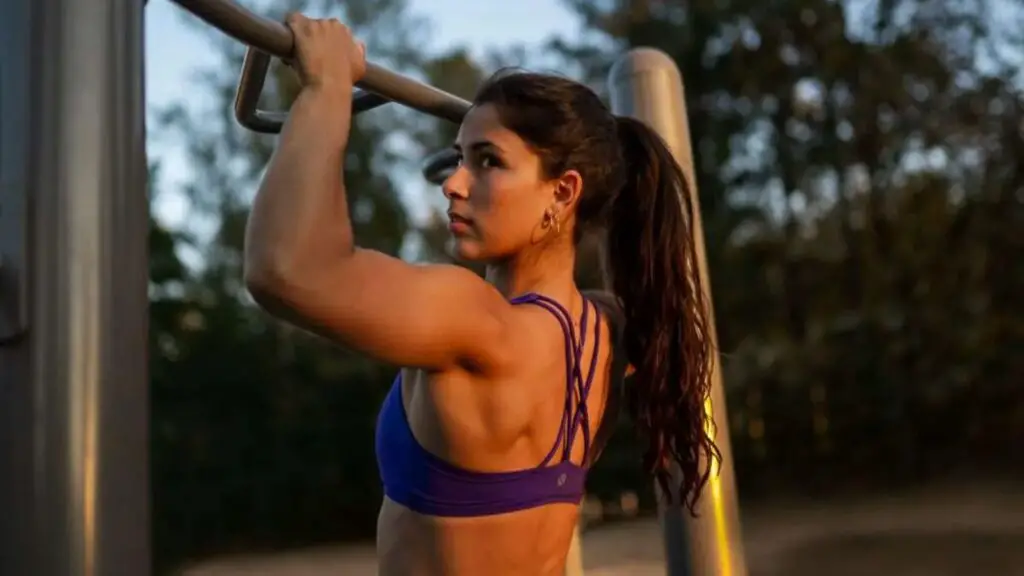Squats are probably the most common form of exercise when working on legs.
In this article we look at everything Squats, helping you understand the different variations and how to do them.
Target Muscle
Squats are a compound exercise that targets multiple muscle groups, making them a highly effective lower body and overall strength-building movement.
The primary target muscles of squats include:
- Quadriceps (Front Thigh Muscles): The quadriceps are heavily engaged during squats. These muscles extend the knee joint and are crucial for the upward phase of the squat.
- Hamstrings (Back Thigh Muscles): The hamstrings play a significant role in stabilizing the knee joint and aiding in hip extension during the upward phase of the squat.
- Gluteus Maximus (Buttocks): The glutes are one of the largest muscle groups in the body and are heavily involved in hip extension during squats. They contribute to the power and stability of the movement.
- Adductors (Inner Thigh Muscles): The adductor muscles, located on the inner thigh, assist in stabilizing the hips and maintaining proper alignment during squats.
- Calves (Gastrocnemius and Soleus): The calf muscles contribute to stabilizing the ankle joint during the squat movement.
- Erector Spinae (Lower Back): The erector spinae muscles of the lower back are engaged to provide stability to the spine during the squat, especially in maintaining an upright torso.
- Abdominals (Core Muscles): The core muscles, including the rectus abdominis and obliques, play a crucial role in stabilizing the spine and maintaining proper posture during squats.
While squats primarily target the lower body muscles, they are also considered a compound movement that engages the core and stabilizer muscles throughout the body.
Benefits
Squats are a compound exercise that engages multiple muscle groups and offers a wide range of benefits for overall health and fitness.
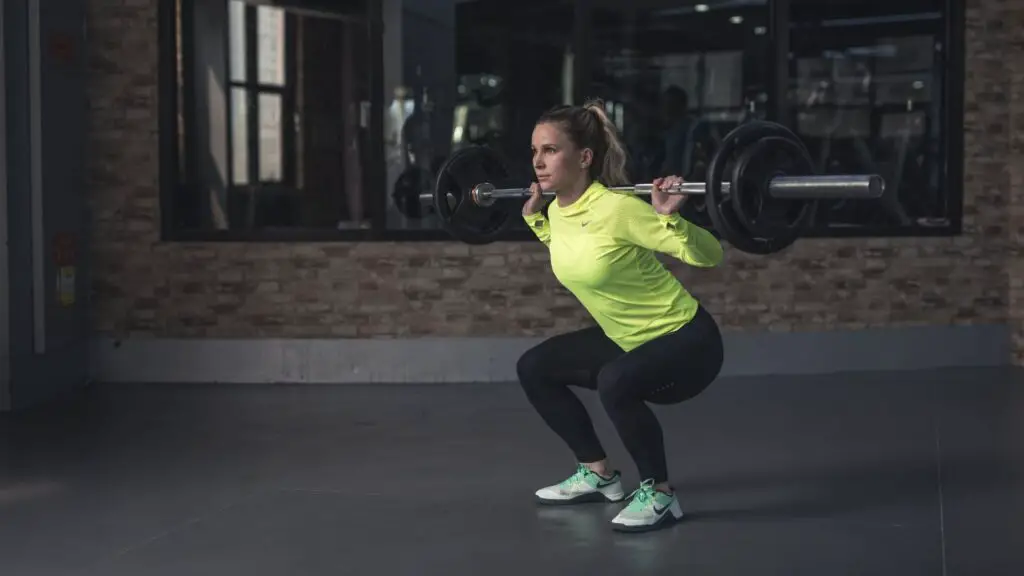
Here are some of the key benefits of incorporating squats into your workout routine:
- Lower Body Strength: Squats are highly effective for building strength in the muscles of the lower body, including the quadriceps, hamstrings, and glutes.
- Muscle Growth (Hypertrophy): Squats, especially when performed with added resistance, can stimulate muscle growth in the targeted muscle groups, contributing to hypertrophy.
- Increased Power and Explosiveness: Squats are a functional movement that helps improve power and explosiveness, which can be beneficial for athletic performance and daily activities.
- Core Activation: Squats require stabilization from the core muscles, including the abdominals and lower back, promoting core strength and stability.
- Improved Joint Health: Performing squats through a full range of motion helps enhance joint flexibility and mobility, contributing to better joint health, especially in the hips, knees, and ankles.
- Calorie Burn and Weight Management: Squats, being a compound exercise, involve multiple muscle groups, leading to increased energy expenditure and supporting weight management and fat loss goals.
- Enhanced Athletic Performance: Squats are a fundamental movement pattern that translates well to various sports and physical activities, improving overall athletic performance.
- Bone Density: Weight-bearing exercises like squats can help increase bone density, reducing the risk of osteoporosis and promoting long-term bone health.
- Functional Movement: Squats mimic everyday movements like sitting and standing, making them a functional exercise that can improve overall movement patterns.
- Improved Posture: Squats strengthen the muscles responsible for maintaining an upright posture, potentially reducing the risk of postural issues.
- Increased Hormone Release: Compound exercises like squats can trigger the release of hormones such as testosterone and growth hormone, which are essential for muscle growth and overall health.
- Versatility: Squats can be performed with various equipment, including bodyweight, barbells, dumbbells, or kettlebells, allowing for versatility in your workout routine.
- Time Efficiency: Squats are a compound movement that targets multiple muscle groups simultaneously, making them a time-efficient option for a full-body workout.
- Mental Toughness: Performing squats, especially with challenging weights, can build mental toughness and discipline, as they require focus, concentration, and determination.
- Accessibility: Squats can be adapted to different fitness levels, making them accessible to a wide range of individuals regardless of their fitness background.
To maximize the benefits and reduce the risk of injury, it’s important to use proper form, start with an appropriate level of resistance, and progressively increase intensity over time.
If you have any health concerns or pre-existing conditions, it’s advisable to consult with a fitness professional or healthcare provider before incorporating squats into your exercise routine.
Variations
There are numerous variations of squats that target different muscle groups, provide varying levels of intensity, and cater to different fitness goals.
Here are some popular squat variations:
Bodyweight Squat
- Stand with feet shoulder-width apart.
- Lower your body by bending your hips and knees, keeping your chest up.
- Squat down until your thighs are parallel to the ground.
- Stand back up to the starting position.
Goblet Squat
- Hold a dumbbell or kettlebell close to your chest.
- Perform a squat while keeping the weight close to your body.
- This variation emphasizes the engagement of the core.
Barbell Back Squat
- Place a barbell on your upper back (traps) behind your neck.
- Squat down by bending your hips and knees.
- Keep your back straight and chest up.
- This is a classic strength-building squat.
Barbell Front Squat
- Hold a barbell across the front of your shoulders.
- Squat down, keeping your elbows high and chest up.
- This variation places more emphasis on the quadriceps and core.
Overhead Squat
- Hold a barbell overhead with a wide grip.
- Squat down while keeping the barbell overhead.
- This challenges stability and mobility throughout the body.
Sumo Squat
- Stand with feet wider than shoulder-width apart and toes pointed outward.
- Squat down, keeping your chest up and back straight.
- This variation targets the inner thighs and glutes.
Bulgarian Split Squat
- Stand a few feet in front of a bench or step.
- Place one foot behind you on the bench.
- Lower your body into a lunge position.
- This isolates each leg and targets the glutes and quads.
Pistol Squat
- Stand on one leg with the other leg extended in front of you.
- Squat down on the standing leg.
- This single-leg squat variation challenges balance and strength.
Box Squat
- Use a box or bench to sit back onto during the squat.
- This variation helps emphasize hip engagement and control.
Hack Squat
- Use a hack squat machine or a Smith machine.
- Position yourself with your back against the machine.
- Squat down with the machine providing guided movement.
Zercher Squat
- Hold a barbell in the crook of your elbows.
- Squat down while keeping the barbell close to your body.
- This variation places emphasis on the upper back and core.
Paused Squat
- Perform a squat and pause at the bottom of the movement.
- This variation increases time under tension, enhancing strength and control.
When incorporating squat variations into your workout routine, it’s essential to choose variations that align with your fitness goals, address specific muscle groups, and suit your current fitness level.
Squats for Beginners
If you’re new to squats, it’s important to start with proper form and gradually progress as your strength and confidence increase.
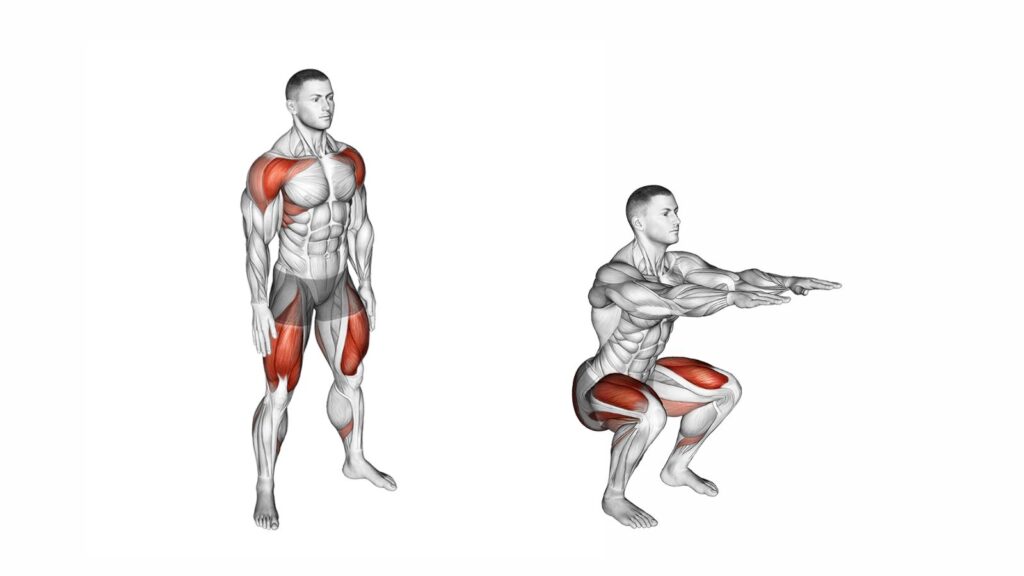
Here’s a step-by-step guide for beginners on how to perform bodyweight squats:
- Setup:
- Stand with your feet shoulder-width apart, toes pointing slightly outward.
- Keep your chest up, shoulders back, and maintain a neutral spine.
- Initiate the Squat:
- Inhale and begin the squat by pushing your hips back as if you’re sitting into a chair.
- Bend your knees and lower your body while keeping your chest up.
- Depth:
- Squat down until your thighs are parallel to the ground or as far as your flexibility allows.
- Ensure your knees are in line with your toes, not collapsing inward.
- Posture:
- Keep your back straight throughout the movement, avoiding excessive rounding or arching.
- Engage your core to help maintain a stable torso.
- Ascent:
- Exhale and push through your heels to return to the starting position.
- Fully extend your hips and knees at the top of the movement.
- Repetition:
- Perform the desired number of repetitions, focusing on controlled and smooth movements.
- Start with a comfortable number of reps, such as 8-12, and gradually increase as you become more comfortable.
Tips:
- Start with Bodyweight: Master the bodyweight squat before adding external resistance like dumbbells or a barbell.
- Use a Mirror: Perform squats in front of a mirror if possible to check your form, ensuring your knees are tracking over your toes and your back remains straight.
- Practice Mobility: Work on hip and ankle mobility to enhance your squat depth. Gradually improve flexibility over time.
- Controlled Movements: Focus on controlled movements rather than speed. This helps build strength and reduces the risk of injury.
- Proper Foot Placement: Keep your feet flat on the ground, distributing your weight evenly through your heels and the balls of your feet.
- Warm-Up: Always warm up before squatting to increase blood flow to the muscles and prepare your body for the exercise.
- Rest Between Sets: Allow adequate rest between sets to recover and maintain proper form.
- Listen to Your Body: If you experience pain (not to be confused with the normal discomfort of muscle fatigue), stop and reassess your form.
- Gradual Progression: As you become more comfortable with bodyweight squats, you can gradually progress to more challenging variations or add resistance.
Remember, consistency is key.
Incorporate squats into your regular workout routine and progressively challenge yourself as you build strength and confidence.
Squats With Weights
Now, once you’ve mastered squatting you can add a little weight to challenge yourself and build more strength and muscle.
Start with a moderate weight that allows for proper form. You can always increase the weight as you become more comfortable.
Squats With Dumbbells
Squats with dumbbells are an excellent way to add resistance to your squatting routine, targeting your lower body muscles while also engaging your core and upper body.
Here’s a step-by-step guide on how to perform squats with dumbbells:
Dumbbell Squats:
- Setup:
- Stand with your feet shoulder-width apart.
- Hold a dumbbell in each hand, allowing them to hang by your sides with your palms facing inward.
- Posture:
- Keep your chest up, shoulders back, and maintain a neutral spine.
- Engage your core to stabilize your torso.
- Initiate the Squat:
- Inhale and begin the squat by pushing your hips back as if sitting into a chair.
- Bend your knees and lower your body while keeping the dumbbells close to your sides.
- Depth:
- Squat down until your thighs are parallel to the ground or as far as your flexibility allows.
- Ensure your knees are in line with your toes, not collapsing inward.
- Posture:
- Keep your back straight throughout the movement, avoiding excessive rounding or arching.
- The dumbbells should hang straight down, and your elbows should remain slightly bent.
- Ascent:
- Exhale and push through your heels to return to the starting position.
- Fully extend your hips and knees at the top of the movement.
- Repetition:
- Perform the desired number of repetitions with controlled and smooth movements.
Keep the dumbbells close to your sides to help maintain balance. Avoid swinging them forward or backward, focus on controlled movements throughout the exercise.
Squats With Resistance Bands
Squats with resistance bands are a great way to add variety and challenge to your lower body workout.
Resistance bands provide continuous tension throughout the movement, targeting your muscles in a slightly different way compared to traditional squats.
Here’s a step-by-step guide on how to perform squats with resistance bands:
Squats with Resistance Bands:
- Setup:
- Place a resistance band just above your knees.
- Stand with your feet shoulder-width apart, ensuring there is tension in the band.
- Posture:
- Keep your chest up, shoulders back, and maintain a neutral spine.
- Engage your core to stabilize your torso.
- Initiate the Squat:
- Inhale and begin the squat by pushing your hips back as if sitting into a chair.
- Bend your knees and lower your body while keeping the tension in the resistance band.
- Depth:
- Squat down until your thighs are parallel to the ground or as far as your flexibility allows.
- Ensure your knees are in line with your toes, not collapsing inward.
- Posture:
- Keep your back straight throughout the movement, avoiding excessive rounding or arching.
- The resistance band will provide continuous tension on your outer thighs and glutes.
- Ascent:
- Exhale and push through your heels to return to the starting position.
- Fully extend your hips and knees at the top of the movement, maintaining tension in the band.
- Repetition:
- Perform the desired number of repetitions with controlled and smooth movements.
Resistance bands come in different levels of resistance, so choose a band that challenges you but still allows for proper form.
Experiment with different band placements, such as above or below the knees, to target various muscle groups.
Squats With Barbell
Performing squats with a barbell is a classic and effective way to build lower body strength and overall muscle development.
Here’s a step-by-step guide on how to do barbell squats:
Barbell Squats:
- Setup:
- Start by setting up a barbell on a squat rack at an appropriate height. The bar should be positioned just below shoulder level.
- Ensure the bar is loaded with an appropriate weight for your fitness level.
- Positioning:
- Step under the bar and place it across your upper back, resting on your trapezius muscles. You can use a high bar position (across the upper traps) or a low bar position (lower on the back).
- Grip the bar with your hands slightly wider than shoulder-width apart.
- Foot Placement:
- Position your feet shoulder-width apart or slightly wider.
- Point your toes slightly outward to accommodate your natural hip and knee movement.
- Posture:
- Keep your chest up and your back straight. Maintain a neutral spine throughout the movement.
- Engage your core to stabilize your torso.
- Initiate the Squat:
- Inhale and begin the squat by pushing your hips back as if sitting into a chair.
- Bend your knees and lower your body while keeping your back straight.
- Depth:
- Squat down until your thighs are parallel to the ground or as far as your flexibility allows.
- Ensure your knees are in line with your toes, not collapsing inward.
- Ascent:
- Exhale and push through your heels to return to the starting position.
- Fully extend your hips and knees at the top of the movement.
- Repetition:
- Perform the desired number of repetitions with controlled and smooth movements.
Keep the barbell cantered over your midfoot throughout the movement to maintain balance. Experiment with foot placement to find what feels most comfortable and allows for proper depth.
If you’re lifting heavy, it’s good to have a spotter, especially when attempting near-maximal lifts.
Squats With Kettlebell
Squats with a kettlebell are an excellent variation of the traditional squat that adds an extra challenge to your lower body workout. Here’s a step-by-step guide on how to perform squats with a kettlebell:
Kettlebell Squats:
- Setup:
- Place a kettlebell on the floor in front of you.
- Stand with your feet shoulder-width apart, toes pointing slightly outward.
- Grip the Kettlebell:
- Bend at the hips and knees to reach for the kettlebell with both hands.
- Grip the handle of the kettlebell firmly.
- Positioning:
- Lift the kettlebell off the floor, bringing it close to your chest.
- Hold the kettlebell with both hands, keeping your elbows close to your body.
- Posture:
- Keep your chest up, shoulders back, and maintain a neutral spine.
- Engage your core to stabilize your torso.
- Initiate the Squat:
- Inhale and begin the squat by pushing your hips back as if sitting into a chair.
- Bend your knees and lower your body while keeping the kettlebell close to your chest.
- Depth:
- Squat down until your thighs are parallel to the ground or as far as your flexibility allows.
- Ensure your knees are in line with your toes, not collapsing inward.
- Ascent:
- Exhale and push through your heels to return to the starting position.
- Fully extend your hips and knees at the top of the movement.
- Repetition:
- Perform the desired number of repetitions with controlled and smooth movements.
Keep your feet flat on the ground, distributing your weight evenly through your heels and the balls of your feet. Focus on controlled movements throughout the exercise and avoid using momentum to lift the kettlebell.
Squats for Hamstrings
While squats primarily target the quadriceps, glutes, and other muscles in the lower body, they also engage the hamstrings to some extent.
Here are some squat variations that are effective for targeting the hamstrings:
Sumo Squats
- Stand with your feet wider than shoulder-width apart and toes turned outward.
- Squat down, pushing your hips back and keeping your chest up.
- This variation engages the hamstrings more than a traditional squat due to the wider stance.
Bulgarian Split Squats
- Stand a few feet in front of a bench or step.
- Place one foot behind you on the bench.
- Lower your body into a lunge position.
- This variation isolates each leg and targets the hamstrings.
Goblet Squats
- Hold a kettlebell or dumbbell close to your chest with both hands.
- Squat down, keeping your back straight and chest up.
- The goblet squat places more emphasis on the posterior chain, including the hamstrings.
If you’re specifically looking to target the hamstrings, incorporating dedicated hamstring exercises, such as Romanian deadlifts and hamstring curls, into your routine alongside these squat variations can provide a well-rounded approach to hamstring development.
Squats for Glutes
There are several squat variations that can target and strengthen the glutes (buttock muscles), with some more effective that others.
Here are some of the best types of squats to target the glutes:
Pulse Squats
- Perform a regular squat but add a series of small pulses at the bottom of the movement.
- This increases time under tension and engages the glutes more intensely.
Box Squats
- Stand in front of a box or bench.
- Squat down, sitting back onto the box.
- Push through your heels to stand back up.
- This variation places emphasis on the glutes and helps with proper form.
Single-Leg Squats (Pistol Squats)
- Lift one leg off the ground and squat down on the other leg.
- This unilateral movement engages the glutes while challenging stability.
Remember to use proper form, including maintaining a neutral spine and pushing through your heels during each squat variation.
It’s also beneficial to incorporate a mix of these exercises into your routine to target the glutes from different angles.
Squats for Quads
To primarily target the quadriceps (the muscles at the front of your thighs) during squats, you can choose squat variations that place additional emphasis on the quads.
Here are some squat variations that are particularly effective for targeting the quads:
Front Squats:
- Hold a barbell across the front of your shoulders with an overhand grip.
- Keep your elbows high, and stand with your feet shoulder-width apart.
- Squat down, keeping your torso upright and your weight on the front of your feet.
- Front squats shift the emphasis to the quadriceps.
Narrow Stance Squats:
- Stand with your feet close together, narrower than shoulder-width apart.
- Squat down, keeping your chest up.
- A narrow stance can target the quadriceps more intensely.
Sissy Squats:
- Stand with your feet shoulder-width apart and hold onto a fixed surface for support.
- Lean back, bending your knees and pushing your hips forward.
- Lower your body down while keeping your torso upright.
- Sissy squats place a strong emphasis on the quads.
It’s essential to include a mix of exercises in your routine to provide overall lower body development, without overworking one specific muscle. This can cause an imbalance and have a negative impact on your body.
Squats for Inner Thighs
While squats primarily target the muscles of the quadriceps, hamstrings, and glutes, you can modify your squat technique to engage the inner thighs to a greater extent.
Here are a few squat variations and techniques that may help target the inner thighs:
Sumo Squats:
- Stand with your feet wider than shoulder-width apart and toes turned outward.
- Squat down, pushing your hips back and keeping your chest up.
- The wider stance in sumo squats can engage the inner thighs more than a traditional squat.
Plie Squats:
- Similar to sumo squats, stand with your feet wider than shoulder-width apart and toes turned outward.
- Squat down, keeping your back straight and chest up.
- Plie squats target the inner thighs and adductors.
Inner Thigh Squeeze Squats:
- Stand with your feet hip-width apart.
- Place a small exercise ball between your thighs.
- As you squat down, consciously squeeze the ball with your inner thighs.
- This adds resistance to the inner thighs during the squat.
It can also be beneficial to add other targeted inner thigh exercises like leg lifts or adductor machine exercises in your routine can complement your efforts.
Squats for Recovery
Squats can be incorporated into a recovery routine when performed with a focus on lower intensity and proper form.
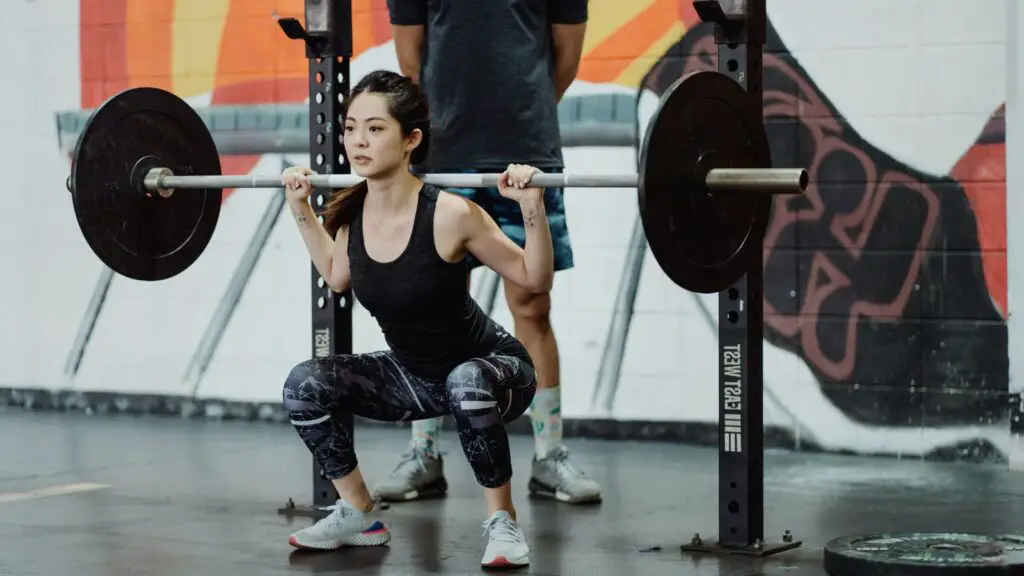
Listening to your body and tailoring the exercises to your individual needs is crucial for an effective recovery routine.
Squats for Back Pain
If you have back pain, performing squats requires caution and proper form to avoid exacerbating the issue. However, squats can be beneficial for strengthening the muscles that support your spine when done correctly.
Here are some tips for performing squats with back pain:
Bodyweight Squats:
- Start with bodyweight squats to focus on form and control without adding extra resistance.
- Stand with your feet shoulder-width apart and lower your body by bending your knees and hips.
- Keep your back straight and chest up, and avoid rounding your lower back.
Goblet Squats:
- Hold a light dumbbell or kettlebell close to your chest.
- This front-loaded squat variation encourages an upright posture and can be less stressful on the lower back.
Pay close attention to your squat technique. Keep your spine neutral, engage your core, and distribute the weight evenly through your feet.
Squats for Bad Knees
If you have knee issues or discomfort, it’s essential to approach squats with caution and potentially modify the exercise to accommodate your condition.
Here are some squats that can be helpful for bad knees:
Chair Squats
- Use a sturdy chair for support.
- Stand in front of the chair and lower yourself until you touch the seat, then stand back up.
- This reduces the load on the knees and provides a controlled range of motion.
Wall Squats:
- Stand with your back against a wall.
- Slide down into a squat position with the support of the wall.
- This helps maintain proper form and control.
Always prioritize comfort and pain-free movement over intensity. If you experience persistent pain or discomfort, discontinue the exercise and consult with a healthcare professional.
FAQs
Are Squats Bad For Your Knees?
Squats are generally not bad for your knees when performed with proper technique and within your physical capabilities.
Squats are considered one of the most effective compound exercises for building strength in the lower body, including the quadriceps, hamstrings, and glutes.
Improper squatting technique or attempting to lift too much weight without proper preparation can potentially lead to knee issues or injuries.
Remember that everyone’s body is different, and what works well for one person may not be suitable for another.
If you experience persistent knee pain or discomfort, it’s crucial to seek advice from a healthcare professional to identify any underlying issues and receive proper guidance.
Should I Do Squats With Knee Pain?
If you are experiencing knee pain, it is generally not advisable to continue doing squats without addressing the underlying issue. It can potentially exacerbate knee pain and lead to further injury.
If your knee pain persists or worsens, refrain from any activity that aggravates it and consult with a healthcare professional for proper diagnosis and treatment.
Why Squats Hurt Lower Back?
Squats can cause lower back pain for several reasons, often related to improper form, muscle imbalances, or pre-existing conditions.
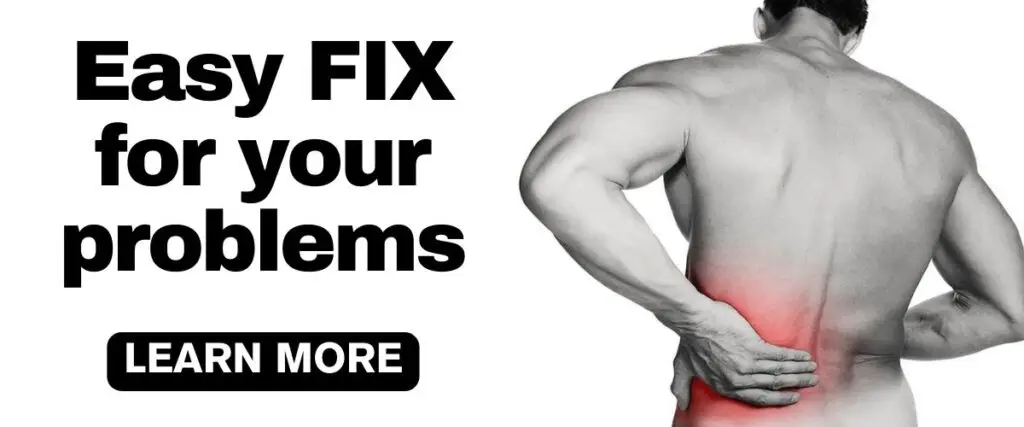
Here are some common reasons why squats may contribute to lower back pain:
- Poor Form
- Lack of Core Activation
- Muscle Imbalances
- Overarching the Lower Back
- Lifting Too Heavy
- Flexibility Issues
- Previous Injuries
Are Squats Enough For Leg Day?
Squats are an excellent compound exercise that targets multiple muscles in the lower body, including the quadriceps, hamstrings, glutes, and lower back.
Generally, just doing squats isn’t enough for a leg day, because it doesn’t provide a balance to your overall legs, targeting only specific muscles.
Remember that a well-rounded leg workout should include a mix of compound and isolation exercises to target different muscles and movement patterns.
Which Squats Are Most Effective?
As discussed in this article, there are various squat variations, each targeting different muscles and offering unique benefits.
The effectiveness of a squat depends on your fitness goals, individual biomechanics, and any specific considerations such as joint health or injuries.

